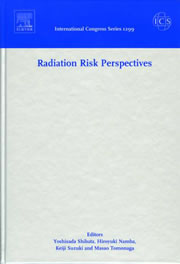|
Preface The practical use of nuclear radiation has extended to various fields including medicine, agriculture, science and engineering, and atomic energy has come to comprise a significant portion of the electric power generated in many countries. The effects of radiation on human health have been investigated in atomic bomb survivors for more than half a century, and the knowledge thus obtained has greatly enriched our understanding. However, so far, the health effects observed in the population based around Chernobyl have contrasted with those seen in Japan’s atomic bomb survivors. No significant increase in leukemia has been noted, while a significant increase in childhood thyroid cancer was observed. These findings suggest that the external radiation dose that the Chernobyl population received was relatively low compared with the exposure suffered by survivors of Hiroshima and Nagasaki, and it is believed that childhood thyroid cancer was caused by internal exposure to radioiodine taken through milk and other sources. If the accident had been officially disclosed and appropriate measures taken soon after its occurrence, the incidence of childhood thyroid cancer might have been much reduced. The Chernobyl accident demonstrates the necessity of risk management and communication as well as risk evaluation. Recognizing the importance of research on low-dose or low-dose-rate radiation, we proposed the launch of a project titled “The International Consortium for Medical Care of Hibakusha and Radiation Life Science” as a 21st Century COE Program. Our aim was to create an international base for studies on the health effects of low-dose and low -dose-rate radiation from the viewpoint of epidemiology, molecular epidemiology and radiation biology. This proposal was accepted in October 2002 by the Japanese Ministry of Education, Culture, Sports, Science and Technology, and the inaugural symposium titled “The First Nagasaki Symposium of the International Consortium for Medical Care of Hibakusha and Radiation Life Science” and one-day satellite meetings were held at the Pompe van Meerdervoort Hall, Nagasaki University School of Medicine in February 2003. More than 100 scientists, including 18 scientists from seven overseas countries, participated in the symposium and satellite meetings and engaged in intensive discussions on the above issues. Following this, three international meetings were held: “Clinical and Epidemiological Approaches to Radiation-associated Thyroid and Breast Cancers”, Nagasaki, March 2004; “Young Scientists Organizing Nagasaki Symposium of International Consortium for Medical Care of Hibakusha and Radiation Life Science”, Nagasaki, March 2005; and “WHO and Nagasaki University Joint International Seminar”, Genava, September 2005. To provide an overview of the progress of our COE Program in the last four years and to discuss issues for future investigation, we held “The Second Nagasaki Symposium of International Consortium for Medical Care of Hibakusha and Radiation Life Science” at the Pompe van Meerdervoort Hall, Nagasaki University School of Medicine, July 26-27, 2006. This consortium was also accompanied by a one-day satellite meeting. More than 130 scientists, including 28 scientists visiting from eight countries, participated in the symposium and satellite meeting. The present volume is a compilation of 39 papers presented at the 2006 symposium and satellite meeting. We would like to express our sincere thanks to all contributors for these fascinating and valuable papers. If this volume helps to inspire readers to conduct further investigations into the deleterious effects on human health of nuclear radiation, especially at low dose or low dose-rate, then our efforts will be amply rewarded. The Editors |
